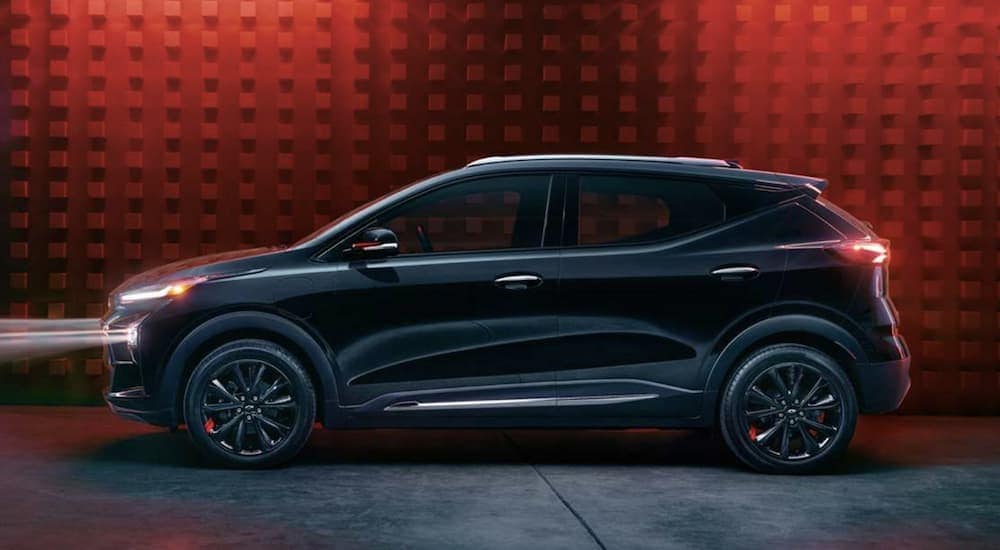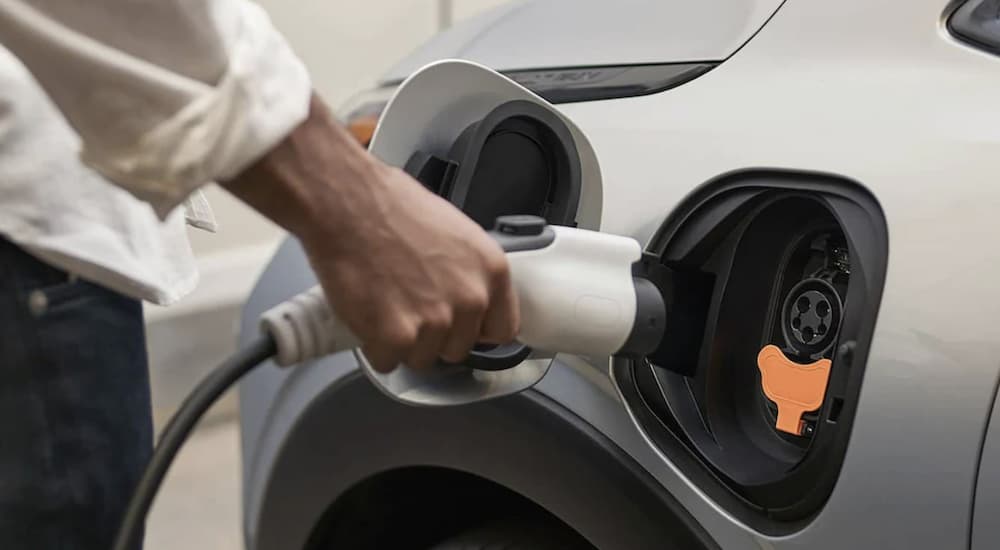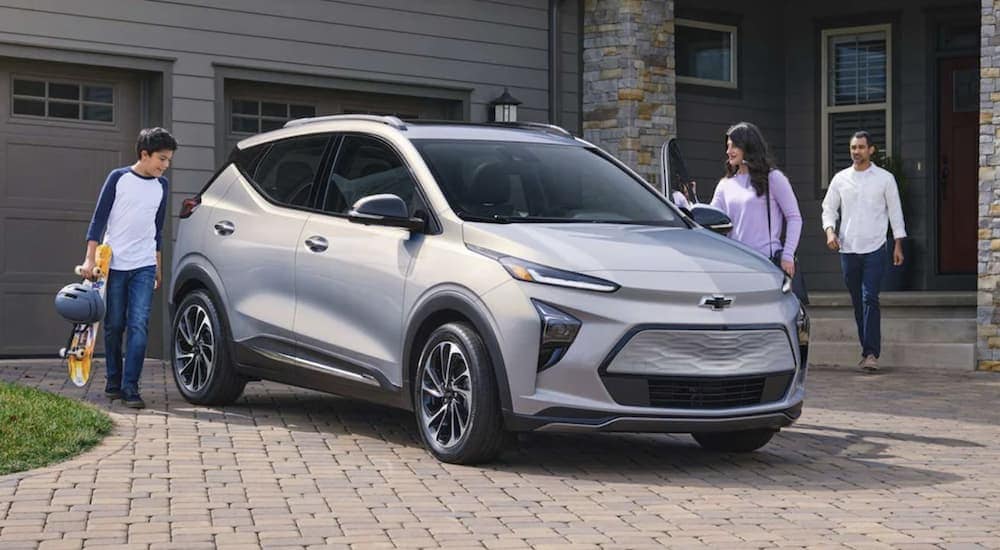
The Chevy Bolt EUV is still somewhat of a new addition to the automotive market, which is why many drivers like to have an in-depth conversation with their Chevy Bolt dealer before buying. Some of the most common questions we get here at Future Chevrolet of Sacramento involve battery life and charging. These are great questions! As drivers, we’ve become accustomed to stopping at a gas station every so many miles to fill up. But with an electric vehicle, things are a bit different. You can’t just throw some gasoline in the tank and speed off––charging takes a little more time, depending on how low on charge you are and what type of charging method you’re using.
For some drivers, that might seem inconvenient on the surface. However, with a little practice and understanding, charging an electric vehicle will become a regular part of your schedule and can actually be more convenient than stopping at a gas station. To clear things up, here are some of the most common questions we’ve received regarding the Chevy Bolt EUV. While it’s definitely a different process than most of us are used to, many drivers find that the learning curve for the switch to electric isn’t as difficult as they might fear.
How Many Miles Will a Chevy Bolt EUV Last Between Charges?
Every Chevy Bolt dealer has been asked how long the Bolt can last between charges. The 2022 Chevy Bolt EUV has been engineered to provide 247 miles of driving on a full charge, which is enough to travel from Sacramento to San Jose and back without recharging. However, the real-world range depends on a lot of factors.
Just as with driving a gasoline-powered vehicle, different driving conditions will have an impact on how far you can drive between Full and Empty. This includes how fast you’re driving, how many passengers you are carrying, and how many accessories you have running inside the car that require power. However, electric vehicles behave a little differently than gasoline cars. For instance, you will likely discover that the Bolt EUV gets better range in stop-and-go Sacramento traffic than cruising on the highway.
Fortunately, the Chevy Bolt EUV provides drivers with detailed feedback on how much energy it is consuming and when it’s time to think about charging. In fact, Chevy makes this process as easy as possible with built-in technology that helps drivers understand how much battery they’re currently using and how far the vehicle can continue traveling under these conditions. In fact, the Bolt EUV has been designed to make living electric very simple.
Features like Regen on Demand and One Pedal Driving help increase the distance traveled between charges. Chevy’s Energy Assist tools allow drivers to make the most of their battery power with in-app functions such as navigation that uses charge, weather, and road conditions to help you find the most efficient route to your destination. The app also includes over 40,000 charging stations across the United States, drilling down to make sure each charging station is open, available, and compatible with the Bolt EUV.
In fact, the Bolt EUV software connects with EVgo, a public fast-charging system, allowing you to pay for your charge through the onboard app. Drivers can also update their charging settings to maximize charging efficiency and add reminders to plug in or unplug as needed. After some practice, many drivers find keeping a charge in their Chevy Bolt EUV is as simple as keeping your phone or laptop charged.

How Long Does It Take to Charge a Chevy Bolt EUV?
The 2022 Chevy Bolt EUV can recharge 95 miles of range in just 30 minutes at a DC Fast Charging station. However, a 240-volt Level 2 charging station can fully recharge the battery in approximately seven hours. Most drivers do not use DC Fast Charging at a public charging station for their regular power supply since this method can become costly. It can also overheat the battery, which isn’t ideal, either.
Chevy has designed the Bolt EUV to receive most of its charge at home. Included with each car is a dual-level charge cord that can be used with Level 1 or Level 2 charging. Level 1 charging is really a fancy name for using a regular 120-volt three-prong household outlet. This method isn’t very fast, averaging about four miles of range per hour of charge. However, if you keep your Bolt EUV plugged in while you sleep, you will still wake up to 30 or more miles of range than you had when you went to bed. For drivers who have a short daily commute, this is a practical and inexpensive charging option.
Level 2 charging can also be done at home but requires a 240-volt outlet, such as you would use for an electric clothes dryer. However, Chevy is working with Qmerit to provide complementary installation of a Level 2 wall charger for those who buy or lease a Bolt EUV. This method is much faster than Level 1 charging and can fully recharge your battery from empty overnight. This tends to be the most common charging method used by Bolt EUV drivers. There are also public Level 2 charging stations, usually available at places like hotels, restaurants, and shopping malls, which can allow you to top off your car while you are away from home.
How Long Do EV Batteries Last?
EV batteries are a little different than the batteries you put in your remote controls. The lithium-ion battery used in the Bolt EUV is covered by an exclusive eight-year/100,000-mile warranty, and many older Bolts have already exceeded the 100,000-mile mark and are still going strong. This warranty includes 24-hour Roadside Assistance and Courtesy Transportation in the event that the battery is compromised.
Overall, the lifespan of a battery can depend on many factors. For example, weather can impact how long your EV battery lasts. Lithium-ion batteries are somewhat sensitive to heat, which is why the Bolt EUV is engineered to keep your battery pack cool. However, if you live in an area where the weather is extremely hot, your battery pack may seem to drain faster than anticipated.
Additionally, using DC Fast Charging stations regularly can decrease the lifespan of your EV battery. This method provides a significant amount of battery energy in a short period, which creates a lot of heat in the battery pack. Given that heat impacts how well the battery performs, using this type of charging all the time can impact how long your battery will last, as you’ll constantly be overheating the battery. Don’t worry––using a DC Fast Charging station now and then as needed is fine, and charging at home doesn’t have the same impact as regularly subjecting your battery to intense conditions.

Adapting to the Adaptor
As your Chevy Bolt dealer, we will be happy to help provide more details and even hands-on assistance with charging the Bolt EUV. We even have a Level 2 charging station here at our dealership, so we can show you how it works! It may seem a little strange at first, and you may have to set yourself a reminder to plug in the car, but after a bit of practice, many drivers feel it becomes a natural part of the daily routine, like plugging in your cell phone to charge when it’s not in use.
With several available charging options, the Chevy Bolt EUV makes the learning curve easier to follow, as drivers can choose between Level 1, Level 2, and DC Fast Charging as needed. Thanks to Chevy’s Energy Assist technology, it’s easier than ever to plan even the most thrilling road trip, as you’ll have detailed information about how long your charge will last and where you can go for a quick top-off. While they may not sell as much junk food as a gas station, public charging stations make it easy to get the power you need as you drive as far as you please.